CRM in Amazon: Analysis of Customer Relationship Management Report
VerifiedAdded on 2023/01/09
|18
|6510
|50
Report
AI Summary
This report provides a detailed analysis of Customer Relationship Management (CRM), focusing on its application within Amazon. It explores key features of CRM, including external relationships, data inspection, customer interaction channels, retention strategies, complaint handling, and customer satisfaction. The report examines the benefits of a strong CRM system, such as increased customer lifetime value, higher profits, improved reputation, automation, and effective communication. It also assesses the impact of quality management systems on CRM, highlighting the importance of processes like TQM, quality control, and ISO 9001. Furthermore, it evaluates methods used to ensure customer satisfaction, including formal and informal surveys, customer loyalty scores, and feedback mechanisms. The report then evaluates processes for achieving effective CRM, assessing the roles of internal staff and external stakeholders. It analyzes the impact of employee engagement, the use of loyalty schemes, and methods for segmenting customers. Finally, the report reviews CRM within an organization, proposes improvements to processes and staff roles, and discusses the implementation of these improvements, including providing feedback and amendments to the plan.
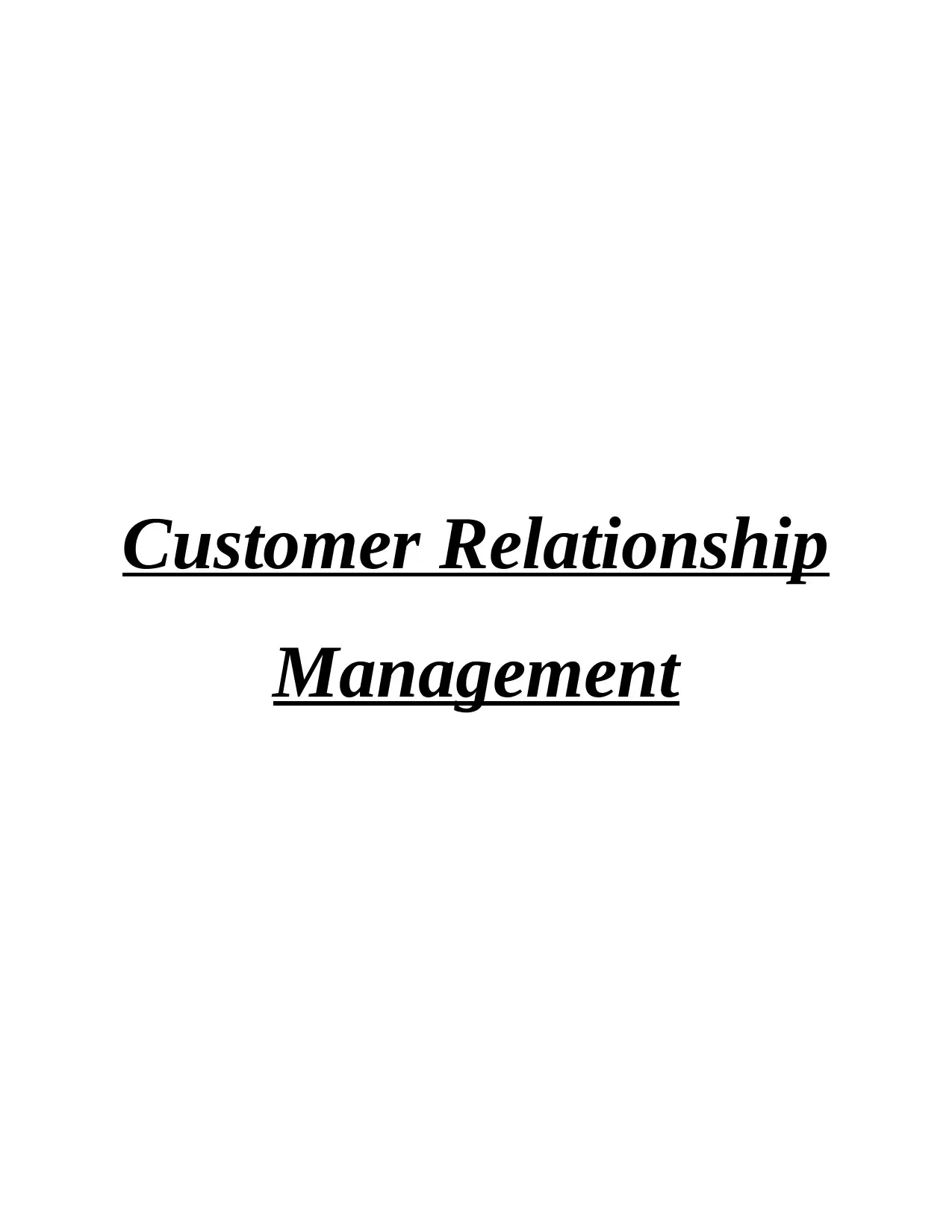
Customer Relationship
Management
Management
Paraphrase This Document
Need a fresh take? Get an instant paraphrase of this document with our AI Paraphraser
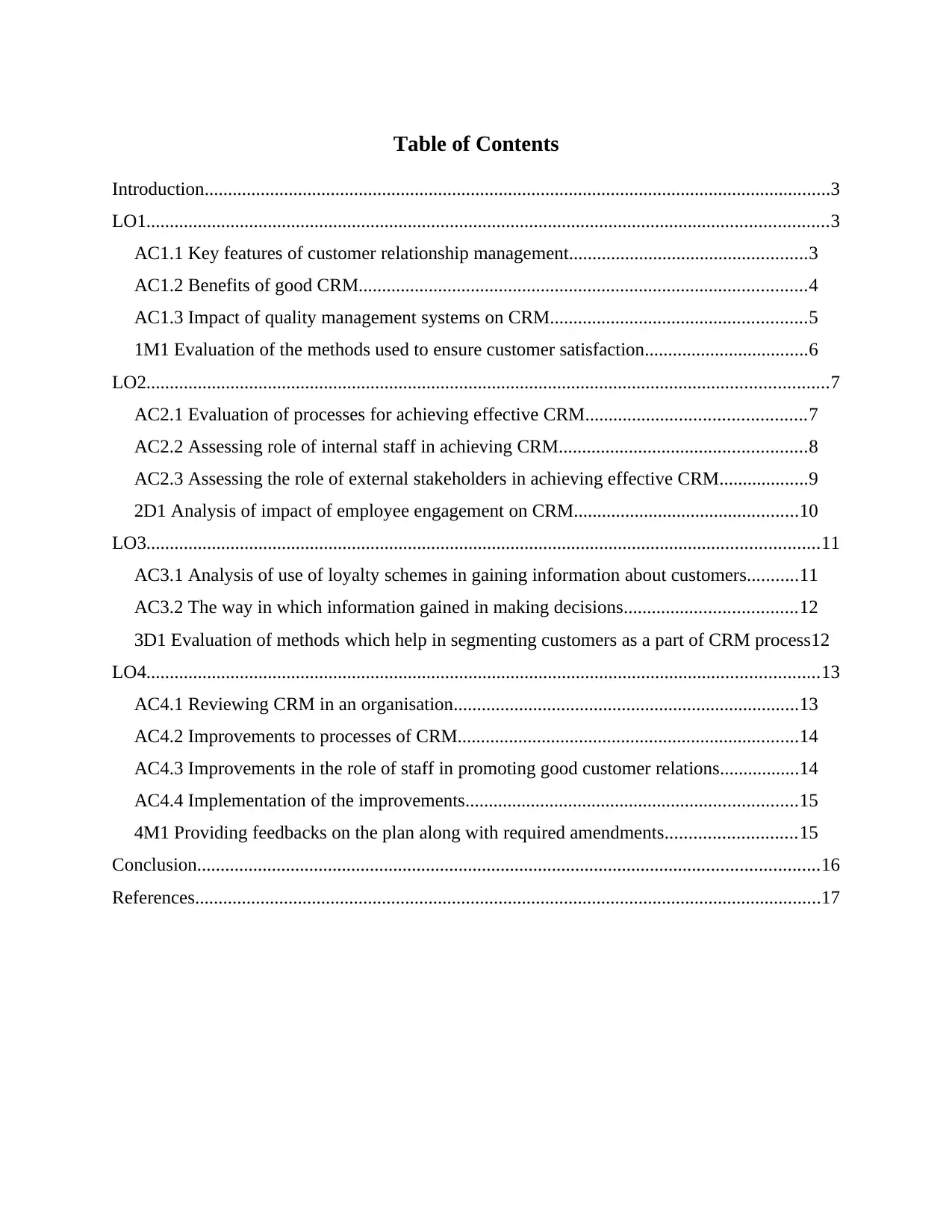
Table of Contents
Introduction......................................................................................................................................3
LO1..................................................................................................................................................3
AC1.1 Key features of customer relationship management...................................................3
AC1.2 Benefits of good CRM................................................................................................4
AC1.3 Impact of quality management systems on CRM.......................................................5
1M1 Evaluation of the methods used to ensure customer satisfaction...................................6
LO2..................................................................................................................................................7
AC2.1 Evaluation of processes for achieving effective CRM...............................................7
AC2.2 Assessing role of internal staff in achieving CRM.....................................................8
AC2.3 Assessing the role of external stakeholders in achieving effective CRM...................9
2D1 Analysis of impact of employee engagement on CRM................................................10
LO3................................................................................................................................................11
AC3.1 Analysis of use of loyalty schemes in gaining information about customers...........11
AC3.2 The way in which information gained in making decisions.....................................12
3D1 Evaluation of methods which help in segmenting customers as a part of CRM process12
LO4................................................................................................................................................13
AC4.1 Reviewing CRM in an organisation..........................................................................13
AC4.2 Improvements to processes of CRM.........................................................................14
AC4.3 Improvements in the role of staff in promoting good customer relations.................14
AC4.4 Implementation of the improvements.......................................................................15
4M1 Providing feedbacks on the plan along with required amendments............................15
Conclusion.....................................................................................................................................16
References......................................................................................................................................17
Introduction......................................................................................................................................3
LO1..................................................................................................................................................3
AC1.1 Key features of customer relationship management...................................................3
AC1.2 Benefits of good CRM................................................................................................4
AC1.3 Impact of quality management systems on CRM.......................................................5
1M1 Evaluation of the methods used to ensure customer satisfaction...................................6
LO2..................................................................................................................................................7
AC2.1 Evaluation of processes for achieving effective CRM...............................................7
AC2.2 Assessing role of internal staff in achieving CRM.....................................................8
AC2.3 Assessing the role of external stakeholders in achieving effective CRM...................9
2D1 Analysis of impact of employee engagement on CRM................................................10
LO3................................................................................................................................................11
AC3.1 Analysis of use of loyalty schemes in gaining information about customers...........11
AC3.2 The way in which information gained in making decisions.....................................12
3D1 Evaluation of methods which help in segmenting customers as a part of CRM process12
LO4................................................................................................................................................13
AC4.1 Reviewing CRM in an organisation..........................................................................13
AC4.2 Improvements to processes of CRM.........................................................................14
AC4.3 Improvements in the role of staff in promoting good customer relations.................14
AC4.4 Implementation of the improvements.......................................................................15
4M1 Providing feedbacks on the plan along with required amendments............................15
Conclusion.....................................................................................................................................16
References......................................................................................................................................17
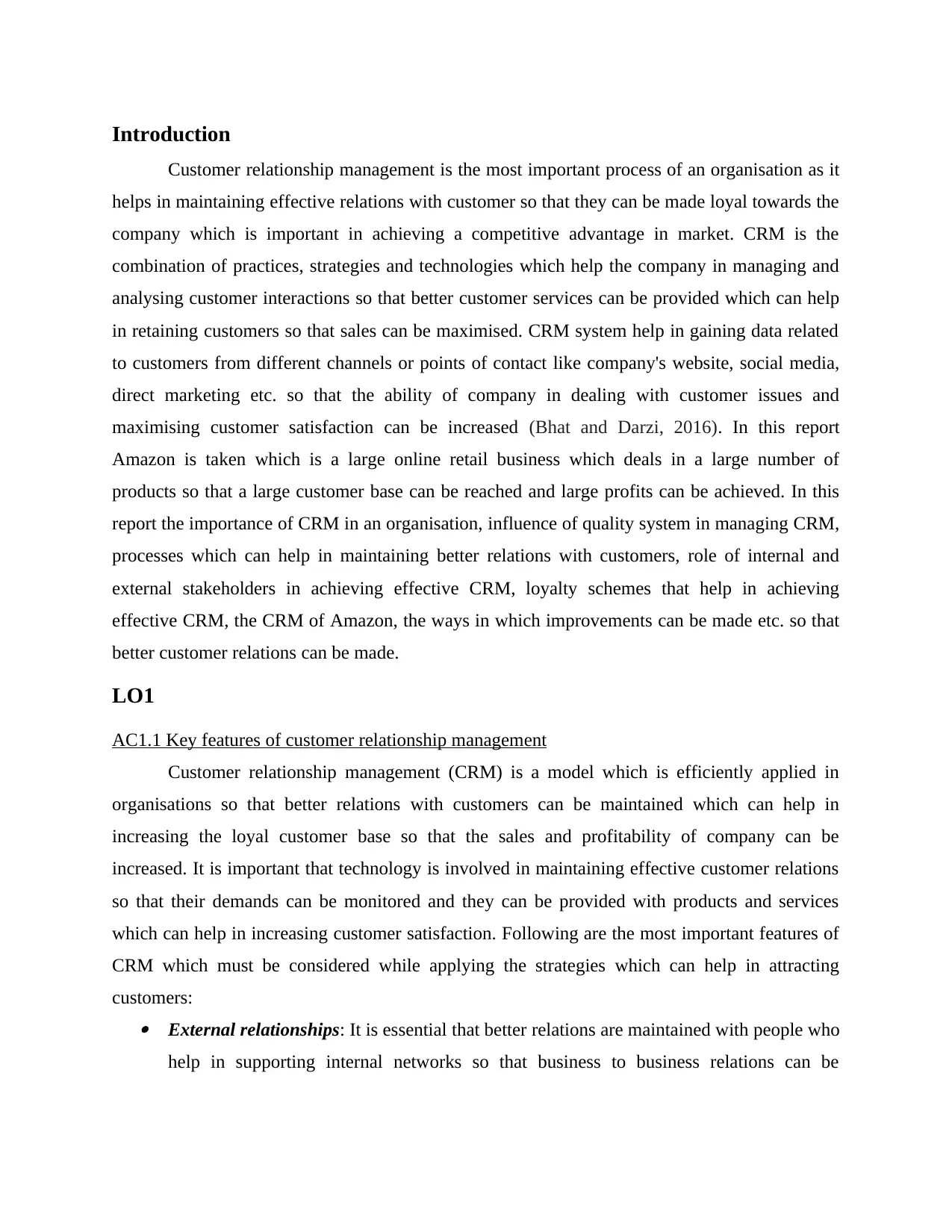
Introduction
Customer relationship management is the most important process of an organisation as it
helps in maintaining effective relations with customer so that they can be made loyal towards the
company which is important in achieving a competitive advantage in market. CRM is the
combination of practices, strategies and technologies which help the company in managing and
analysing customer interactions so that better customer services can be provided which can help
in retaining customers so that sales can be maximised. CRM system help in gaining data related
to customers from different channels or points of contact like company's website, social media,
direct marketing etc. so that the ability of company in dealing with customer issues and
maximising customer satisfaction can be increased (Bhat and Darzi, 2016). In this report
Amazon is taken which is a large online retail business which deals in a large number of
products so that a large customer base can be reached and large profits can be achieved. In this
report the importance of CRM in an organisation, influence of quality system in managing CRM,
processes which can help in maintaining better relations with customers, role of internal and
external stakeholders in achieving effective CRM, loyalty schemes that help in achieving
effective CRM, the CRM of Amazon, the ways in which improvements can be made etc. so that
better customer relations can be made.
LO1
AC1.1 Key features of customer relationship management
Customer relationship management (CRM) is a model which is efficiently applied in
organisations so that better relations with customers can be maintained which can help in
increasing the loyal customer base so that the sales and profitability of company can be
increased. It is important that technology is involved in maintaining effective customer relations
so that their demands can be monitored and they can be provided with products and services
which can help in increasing customer satisfaction. Following are the most important features of
CRM which must be considered while applying the strategies which can help in attracting
customers: External relationships: It is essential that better relations are maintained with people who
help in supporting internal networks so that business to business relations can be
Customer relationship management is the most important process of an organisation as it
helps in maintaining effective relations with customer so that they can be made loyal towards the
company which is important in achieving a competitive advantage in market. CRM is the
combination of practices, strategies and technologies which help the company in managing and
analysing customer interactions so that better customer services can be provided which can help
in retaining customers so that sales can be maximised. CRM system help in gaining data related
to customers from different channels or points of contact like company's website, social media,
direct marketing etc. so that the ability of company in dealing with customer issues and
maximising customer satisfaction can be increased (Bhat and Darzi, 2016). In this report
Amazon is taken which is a large online retail business which deals in a large number of
products so that a large customer base can be reached and large profits can be achieved. In this
report the importance of CRM in an organisation, influence of quality system in managing CRM,
processes which can help in maintaining better relations with customers, role of internal and
external stakeholders in achieving effective CRM, loyalty schemes that help in achieving
effective CRM, the CRM of Amazon, the ways in which improvements can be made etc. so that
better customer relations can be made.
LO1
AC1.1 Key features of customer relationship management
Customer relationship management (CRM) is a model which is efficiently applied in
organisations so that better relations with customers can be maintained which can help in
increasing the loyal customer base so that the sales and profitability of company can be
increased. It is important that technology is involved in maintaining effective customer relations
so that their demands can be monitored and they can be provided with products and services
which can help in increasing customer satisfaction. Following are the most important features of
CRM which must be considered while applying the strategies which can help in attracting
customers: External relationships: It is essential that better relations are maintained with people who
help in supporting internal networks so that business to business relations can be
⊘ This is a preview!⊘
Do you want full access?
Subscribe today to unlock all pages.

Trusted by 1+ million students worldwide
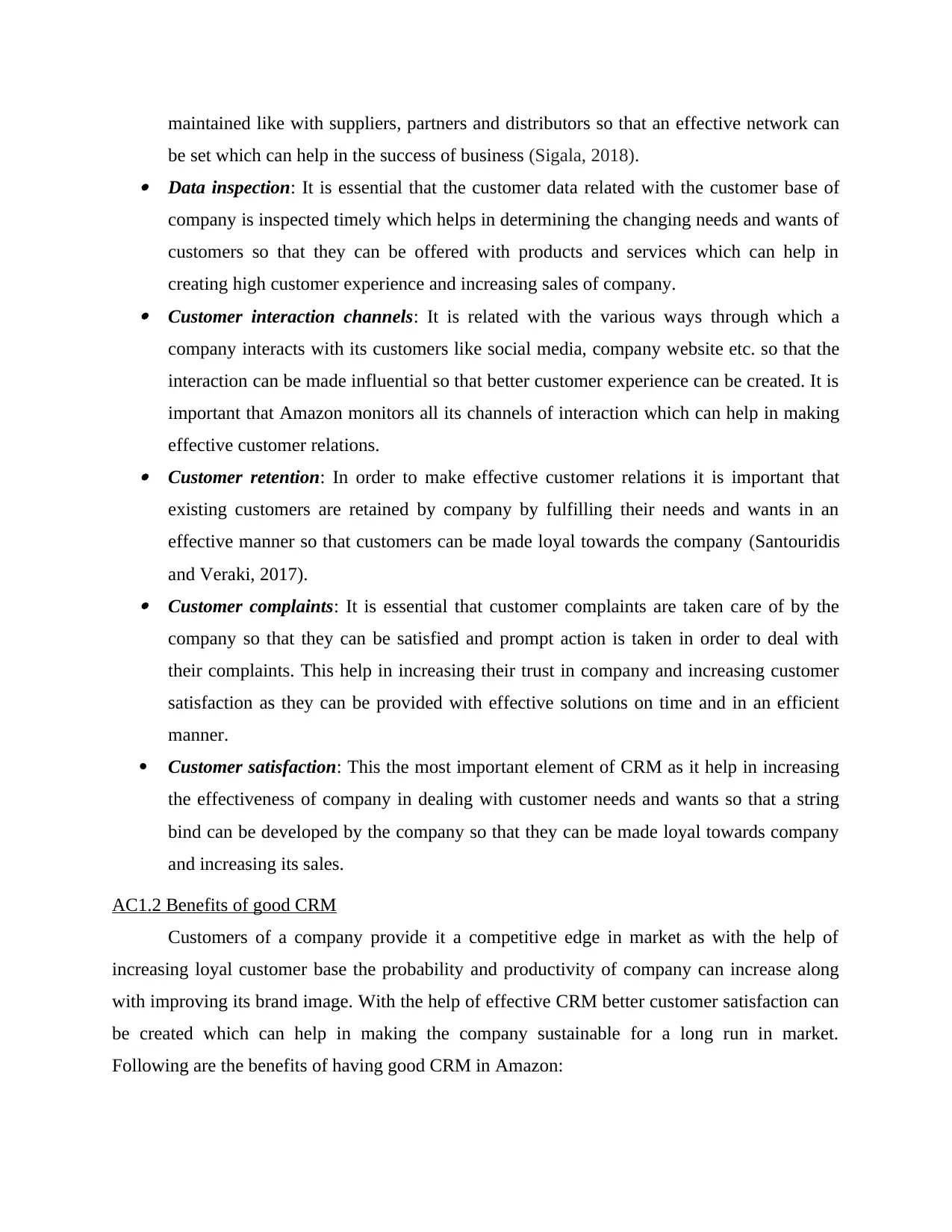
maintained like with suppliers, partners and distributors so that an effective network can
be set which can help in the success of business (Sigala, 2018). Data inspection: It is essential that the customer data related with the customer base of
company is inspected timely which helps in determining the changing needs and wants of
customers so that they can be offered with products and services which can help in
creating high customer experience and increasing sales of company. Customer interaction channels: It is related with the various ways through which a
company interacts with its customers like social media, company website etc. so that the
interaction can be made influential so that better customer experience can be created. It is
important that Amazon monitors all its channels of interaction which can help in making
effective customer relations. Customer retention: In order to make effective customer relations it is important that
existing customers are retained by company by fulfilling their needs and wants in an
effective manner so that customers can be made loyal towards the company (Santouridis
and Veraki, 2017). Customer complaints: It is essential that customer complaints are taken care of by the
company so that they can be satisfied and prompt action is taken in order to deal with
their complaints. This help in increasing their trust in company and increasing customer
satisfaction as they can be provided with effective solutions on time and in an efficient
manner.
Customer satisfaction: This the most important element of CRM as it help in increasing
the effectiveness of company in dealing with customer needs and wants so that a string
bind can be developed by the company so that they can be made loyal towards company
and increasing its sales.
AC1.2 Benefits of good CRM
Customers of a company provide it a competitive edge in market as with the help of
increasing loyal customer base the probability and productivity of company can increase along
with improving its brand image. With the help of effective CRM better customer satisfaction can
be created which can help in making the company sustainable for a long run in market.
Following are the benefits of having good CRM in Amazon:
be set which can help in the success of business (Sigala, 2018). Data inspection: It is essential that the customer data related with the customer base of
company is inspected timely which helps in determining the changing needs and wants of
customers so that they can be offered with products and services which can help in
creating high customer experience and increasing sales of company. Customer interaction channels: It is related with the various ways through which a
company interacts with its customers like social media, company website etc. so that the
interaction can be made influential so that better customer experience can be created. It is
important that Amazon monitors all its channels of interaction which can help in making
effective customer relations. Customer retention: In order to make effective customer relations it is important that
existing customers are retained by company by fulfilling their needs and wants in an
effective manner so that customers can be made loyal towards the company (Santouridis
and Veraki, 2017). Customer complaints: It is essential that customer complaints are taken care of by the
company so that they can be satisfied and prompt action is taken in order to deal with
their complaints. This help in increasing their trust in company and increasing customer
satisfaction as they can be provided with effective solutions on time and in an efficient
manner.
Customer satisfaction: This the most important element of CRM as it help in increasing
the effectiveness of company in dealing with customer needs and wants so that a string
bind can be developed by the company so that they can be made loyal towards company
and increasing its sales.
AC1.2 Benefits of good CRM
Customers of a company provide it a competitive edge in market as with the help of
increasing loyal customer base the probability and productivity of company can increase along
with improving its brand image. With the help of effective CRM better customer satisfaction can
be created which can help in making the company sustainable for a long run in market.
Following are the benefits of having good CRM in Amazon:
Paraphrase This Document
Need a fresh take? Get an instant paraphrase of this document with our AI Paraphraser

Increasing customer life-cycle: With the help of good CRM practices the company can
increase life-cycle of its customers by effectively dealing with their demands and
increasing their satisfaction so that they can continue to purchase products and services
from the same company (Rahimi and Gunlu, 2016). Increased profits: CRM also help in enhancing the profits of company as it help in
increasing its customer base so that its sales can increase thereby improving its
profitability. The increased profits can help in further improving its processes so that it
can provide better customer experience and customers can be engaged in the company
which can help in enhancing their loyalty towards company. Better reputation: As the companies focus more on improving customer experience, its
image in market also gets increased which helps it in attracting new customers so that
customer base can be further increased. Also this can help the company in gaining a
competitive advantage in market by sustaining healthy relations with customers. Increased automation: In order to increase the customer satisfaction it is important that
all the tasks are automated which help in increasing the efficiency with which customers
can interact with company. It also helps in increasing their convenience so that better
customer satisfaction can be generated and the ability of customers in dealing with
company can increase.
Effective communication: CRM also help in improving the efficiency of company in
responding to their customers so that their complaints can be handled in a time efficient
manner which can help in solving customer problems effectively. It also helps in
increasing the customisation of products and services for its customers so that better
services can be provided to customers which can help in increasing their satisfaction (Al-
Weshah, Al-Manasrah and Al-Qatawneh, 2019).
AC1.3 Impact of quality management systems on CRM
Quality management systems must be implemented in an organisation as it help in
improving the processes in company so that highly efficient and qualitative work can take place
in organisation which can also help in enhancing the customer service. Various quality
management systems are applied in Amazon so that high quality work can take place like total
quality management (TQM), quality control and quality assurance methods, strong culture,
effective communication, training of the employees etc. All these collectively help in improving
increase life-cycle of its customers by effectively dealing with their demands and
increasing their satisfaction so that they can continue to purchase products and services
from the same company (Rahimi and Gunlu, 2016). Increased profits: CRM also help in enhancing the profits of company as it help in
increasing its customer base so that its sales can increase thereby improving its
profitability. The increased profits can help in further improving its processes so that it
can provide better customer experience and customers can be engaged in the company
which can help in enhancing their loyalty towards company. Better reputation: As the companies focus more on improving customer experience, its
image in market also gets increased which helps it in attracting new customers so that
customer base can be further increased. Also this can help the company in gaining a
competitive advantage in market by sustaining healthy relations with customers. Increased automation: In order to increase the customer satisfaction it is important that
all the tasks are automated which help in increasing the efficiency with which customers
can interact with company. It also helps in increasing their convenience so that better
customer satisfaction can be generated and the ability of customers in dealing with
company can increase.
Effective communication: CRM also help in improving the efficiency of company in
responding to their customers so that their complaints can be handled in a time efficient
manner which can help in solving customer problems effectively. It also helps in
increasing the customisation of products and services for its customers so that better
services can be provided to customers which can help in increasing their satisfaction (Al-
Weshah, Al-Manasrah and Al-Qatawneh, 2019).
AC1.3 Impact of quality management systems on CRM
Quality management systems must be implemented in an organisation as it help in
improving the processes in company so that highly efficient and qualitative work can take place
in organisation which can also help in enhancing the customer service. Various quality
management systems are applied in Amazon so that high quality work can take place like total
quality management (TQM), quality control and quality assurance methods, strong culture,
effective communication, training of the employees etc. All these collectively help in improving
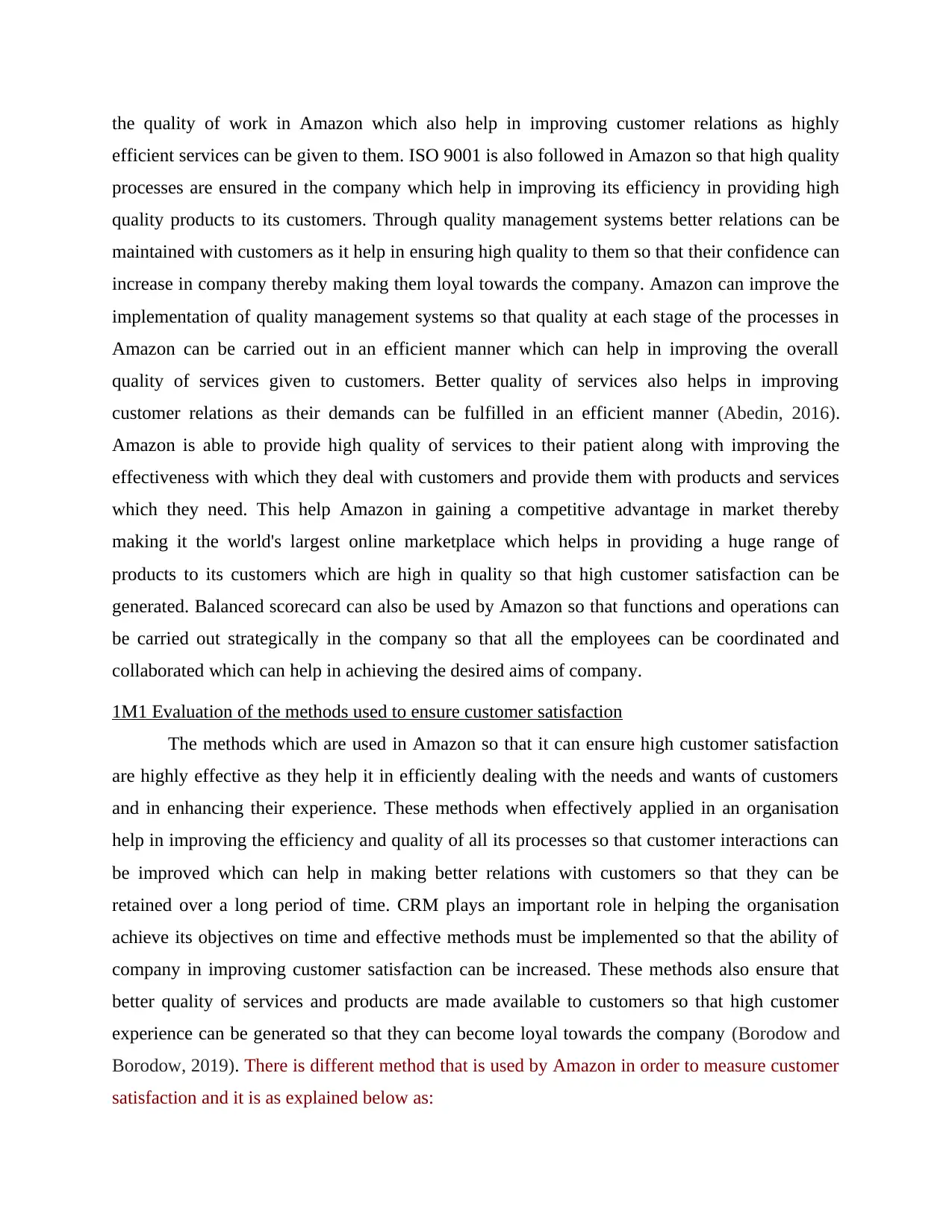
the quality of work in Amazon which also help in improving customer relations as highly
efficient services can be given to them. ISO 9001 is also followed in Amazon so that high quality
processes are ensured in the company which help in improving its efficiency in providing high
quality products to its customers. Through quality management systems better relations can be
maintained with customers as it help in ensuring high quality to them so that their confidence can
increase in company thereby making them loyal towards the company. Amazon can improve the
implementation of quality management systems so that quality at each stage of the processes in
Amazon can be carried out in an efficient manner which can help in improving the overall
quality of services given to customers. Better quality of services also helps in improving
customer relations as their demands can be fulfilled in an efficient manner (Abedin, 2016).
Amazon is able to provide high quality of services to their patient along with improving the
effectiveness with which they deal with customers and provide them with products and services
which they need. This help Amazon in gaining a competitive advantage in market thereby
making it the world's largest online marketplace which helps in providing a huge range of
products to its customers which are high in quality so that high customer satisfaction can be
generated. Balanced scorecard can also be used by Amazon so that functions and operations can
be carried out strategically in the company so that all the employees can be coordinated and
collaborated which can help in achieving the desired aims of company.
1M1 Evaluation of the methods used to ensure customer satisfaction
The methods which are used in Amazon so that it can ensure high customer satisfaction
are highly effective as they help it in efficiently dealing with the needs and wants of customers
and in enhancing their experience. These methods when effectively applied in an organisation
help in improving the efficiency and quality of all its processes so that customer interactions can
be improved which can help in making better relations with customers so that they can be
retained over a long period of time. CRM plays an important role in helping the organisation
achieve its objectives on time and effective methods must be implemented so that the ability of
company in improving customer satisfaction can be increased. These methods also ensure that
better quality of services and products are made available to customers so that high customer
experience can be generated so that they can become loyal towards the company (Borodow and
Borodow, 2019). There is different method that is used by Amazon in order to measure customer
satisfaction and it is as explained below as:
efficient services can be given to them. ISO 9001 is also followed in Amazon so that high quality
processes are ensured in the company which help in improving its efficiency in providing high
quality products to its customers. Through quality management systems better relations can be
maintained with customers as it help in ensuring high quality to them so that their confidence can
increase in company thereby making them loyal towards the company. Amazon can improve the
implementation of quality management systems so that quality at each stage of the processes in
Amazon can be carried out in an efficient manner which can help in improving the overall
quality of services given to customers. Better quality of services also helps in improving
customer relations as their demands can be fulfilled in an efficient manner (Abedin, 2016).
Amazon is able to provide high quality of services to their patient along with improving the
effectiveness with which they deal with customers and provide them with products and services
which they need. This help Amazon in gaining a competitive advantage in market thereby
making it the world's largest online marketplace which helps in providing a huge range of
products to its customers which are high in quality so that high customer satisfaction can be
generated. Balanced scorecard can also be used by Amazon so that functions and operations can
be carried out strategically in the company so that all the employees can be coordinated and
collaborated which can help in achieving the desired aims of company.
1M1 Evaluation of the methods used to ensure customer satisfaction
The methods which are used in Amazon so that it can ensure high customer satisfaction
are highly effective as they help it in efficiently dealing with the needs and wants of customers
and in enhancing their experience. These methods when effectively applied in an organisation
help in improving the efficiency and quality of all its processes so that customer interactions can
be improved which can help in making better relations with customers so that they can be
retained over a long period of time. CRM plays an important role in helping the organisation
achieve its objectives on time and effective methods must be implemented so that the ability of
company in improving customer satisfaction can be increased. These methods also ensure that
better quality of services and products are made available to customers so that high customer
experience can be generated so that they can become loyal towards the company (Borodow and
Borodow, 2019). There is different method that is used by Amazon in order to measure customer
satisfaction and it is as explained below as:
⊘ This is a preview!⊘
Do you want full access?
Subscribe today to unlock all pages.

Trusted by 1+ million students worldwide
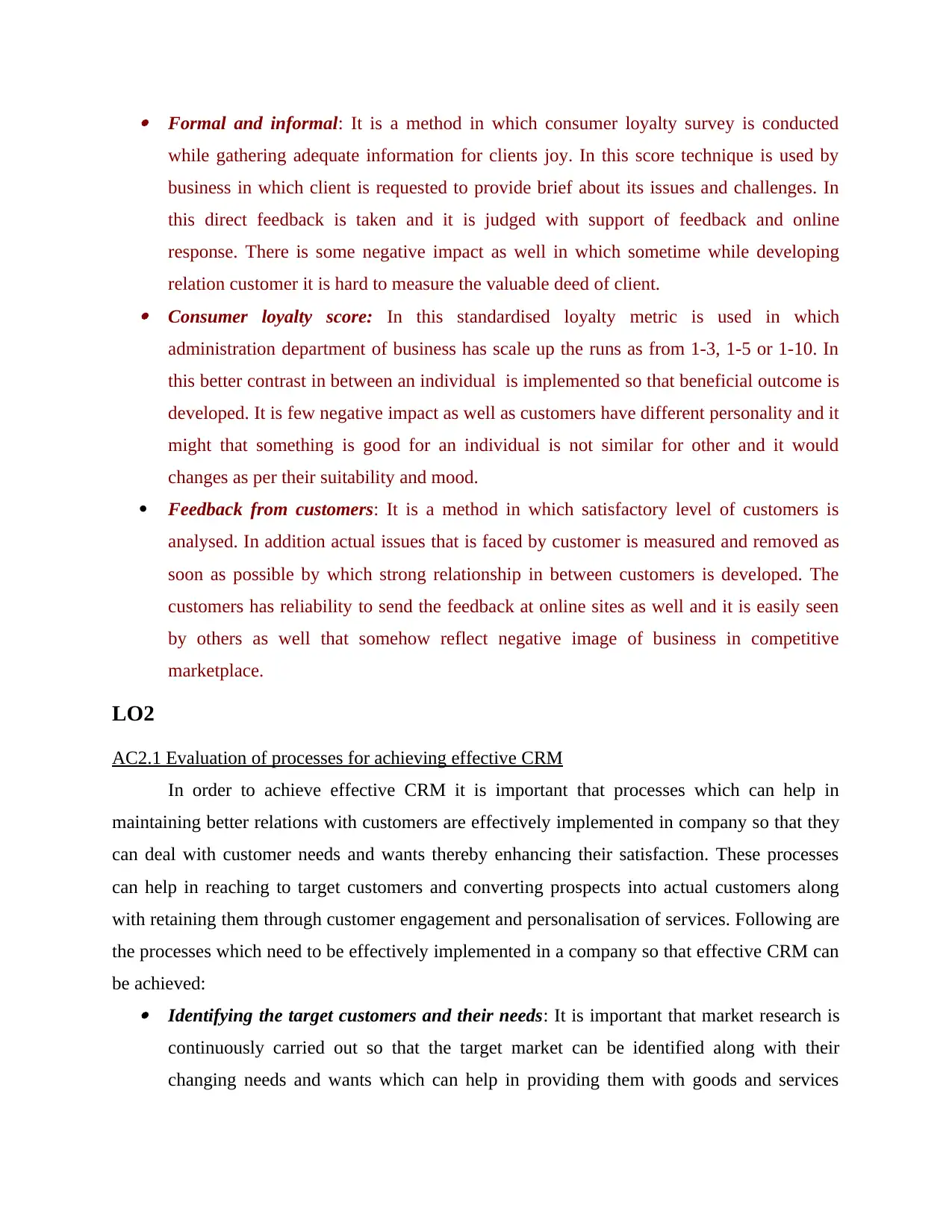
Formal and informal: It is a method in which consumer loyalty survey is conducted
while gathering adequate information for clients joy. In this score technique is used by
business in which client is requested to provide brief about its issues and challenges. In
this direct feedback is taken and it is judged with support of feedback and online
response. There is some negative impact as well in which sometime while developing
relation customer it is hard to measure the valuable deed of client. Consumer loyalty score: In this standardised loyalty metric is used in which
administration department of business has scale up the runs as from 1-3, 1-5 or 1-10. In
this better contrast in between an individual is implemented so that beneficial outcome is
developed. It is few negative impact as well as customers have different personality and it
might that something is good for an individual is not similar for other and it would
changes as per their suitability and mood.
Feedback from customers: It is a method in which satisfactory level of customers is
analysed. In addition actual issues that is faced by customer is measured and removed as
soon as possible by which strong relationship in between customers is developed. The
customers has reliability to send the feedback at online sites as well and it is easily seen
by others as well that somehow reflect negative image of business in competitive
marketplace.
LO2
AC2.1 Evaluation of processes for achieving effective CRM
In order to achieve effective CRM it is important that processes which can help in
maintaining better relations with customers are effectively implemented in company so that they
can deal with customer needs and wants thereby enhancing their satisfaction. These processes
can help in reaching to target customers and converting prospects into actual customers along
with retaining them through customer engagement and personalisation of services. Following are
the processes which need to be effectively implemented in a company so that effective CRM can
be achieved: Identifying the target customers and their needs: It is important that market research is
continuously carried out so that the target market can be identified along with their
changing needs and wants which can help in providing them with goods and services
while gathering adequate information for clients joy. In this score technique is used by
business in which client is requested to provide brief about its issues and challenges. In
this direct feedback is taken and it is judged with support of feedback and online
response. There is some negative impact as well in which sometime while developing
relation customer it is hard to measure the valuable deed of client. Consumer loyalty score: In this standardised loyalty metric is used in which
administration department of business has scale up the runs as from 1-3, 1-5 or 1-10. In
this better contrast in between an individual is implemented so that beneficial outcome is
developed. It is few negative impact as well as customers have different personality and it
might that something is good for an individual is not similar for other and it would
changes as per their suitability and mood.
Feedback from customers: It is a method in which satisfactory level of customers is
analysed. In addition actual issues that is faced by customer is measured and removed as
soon as possible by which strong relationship in between customers is developed. The
customers has reliability to send the feedback at online sites as well and it is easily seen
by others as well that somehow reflect negative image of business in competitive
marketplace.
LO2
AC2.1 Evaluation of processes for achieving effective CRM
In order to achieve effective CRM it is important that processes which can help in
maintaining better relations with customers are effectively implemented in company so that they
can deal with customer needs and wants thereby enhancing their satisfaction. These processes
can help in reaching to target customers and converting prospects into actual customers along
with retaining them through customer engagement and personalisation of services. Following are
the processes which need to be effectively implemented in a company so that effective CRM can
be achieved: Identifying the target customers and their needs: It is important that market research is
continuously carried out so that the target market can be identified along with their
changing needs and wants which can help in providing them with goods and services
Paraphrase This Document
Need a fresh take? Get an instant paraphrase of this document with our AI Paraphraser
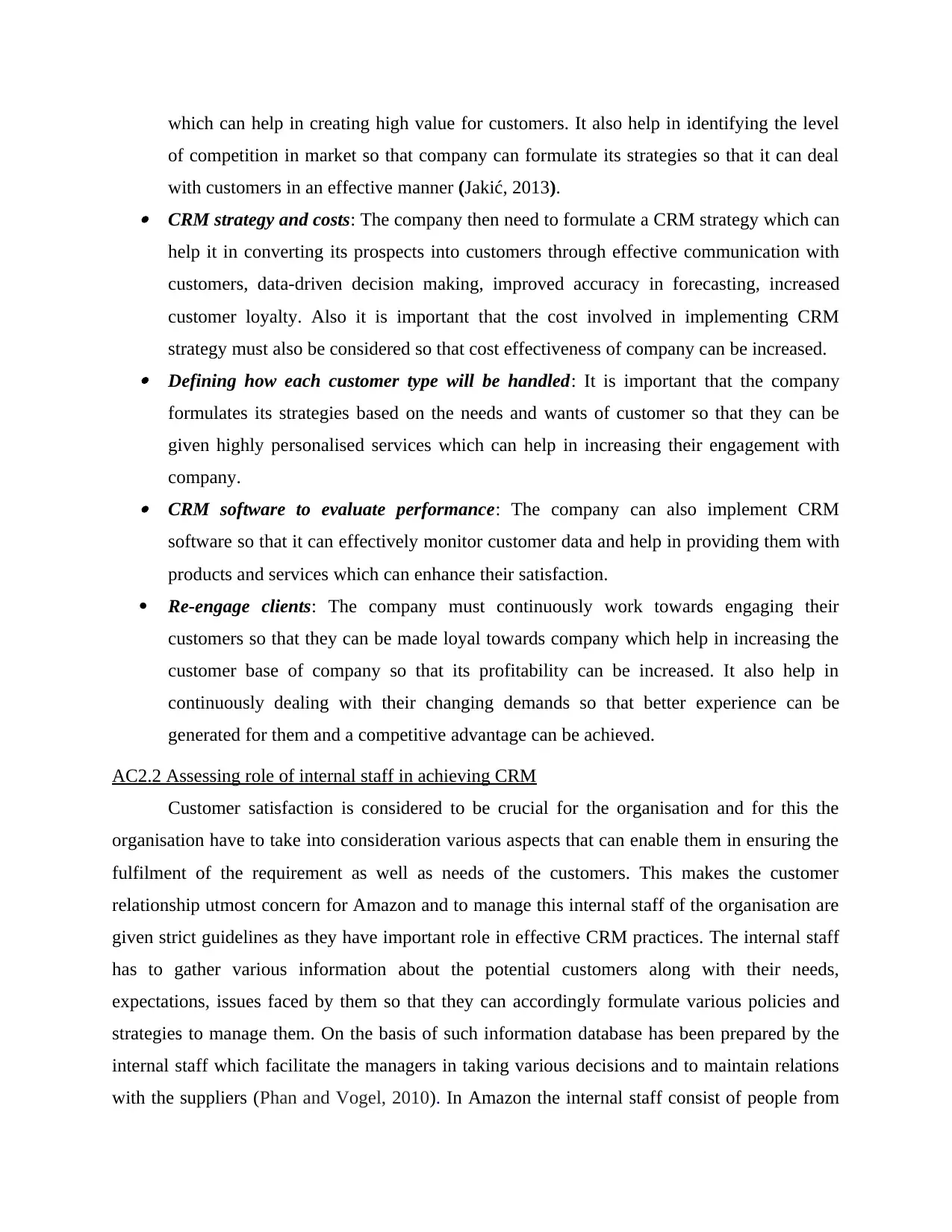
which can help in creating high value for customers. It also help in identifying the level
of competition in market so that company can formulate its strategies so that it can deal
with customers in an effective manner (Jakić, 2013). CRM strategy and costs: The company then need to formulate a CRM strategy which can
help it in converting its prospects into customers through effective communication with
customers, data-driven decision making, improved accuracy in forecasting, increased
customer loyalty. Also it is important that the cost involved in implementing CRM
strategy must also be considered so that cost effectiveness of company can be increased. Defining how each customer type will be handled: It is important that the company
formulates its strategies based on the needs and wants of customer so that they can be
given highly personalised services which can help in increasing their engagement with
company. CRM software to evaluate performance: The company can also implement CRM
software so that it can effectively monitor customer data and help in providing them with
products and services which can enhance their satisfaction.
Re-engage clients: The company must continuously work towards engaging their
customers so that they can be made loyal towards company which help in increasing the
customer base of company so that its profitability can be increased. It also help in
continuously dealing with their changing demands so that better experience can be
generated for them and a competitive advantage can be achieved.
AC2.2 Assessing role of internal staff in achieving CRM
Customer satisfaction is considered to be crucial for the organisation and for this the
organisation have to take into consideration various aspects that can enable them in ensuring the
fulfilment of the requirement as well as needs of the customers. This makes the customer
relationship utmost concern for Amazon and to manage this internal staff of the organisation are
given strict guidelines as they have important role in effective CRM practices. The internal staff
has to gather various information about the potential customers along with their needs,
expectations, issues faced by them so that they can accordingly formulate various policies and
strategies to manage them. On the basis of such information database has been prepared by the
internal staff which facilitate the managers in taking various decisions and to maintain relations
with the suppliers (Phan and Vogel, 2010). In Amazon the internal staff consist of people from
of competition in market so that company can formulate its strategies so that it can deal
with customers in an effective manner (Jakić, 2013). CRM strategy and costs: The company then need to formulate a CRM strategy which can
help it in converting its prospects into customers through effective communication with
customers, data-driven decision making, improved accuracy in forecasting, increased
customer loyalty. Also it is important that the cost involved in implementing CRM
strategy must also be considered so that cost effectiveness of company can be increased. Defining how each customer type will be handled: It is important that the company
formulates its strategies based on the needs and wants of customer so that they can be
given highly personalised services which can help in increasing their engagement with
company. CRM software to evaluate performance: The company can also implement CRM
software so that it can effectively monitor customer data and help in providing them with
products and services which can enhance their satisfaction.
Re-engage clients: The company must continuously work towards engaging their
customers so that they can be made loyal towards company which help in increasing the
customer base of company so that its profitability can be increased. It also help in
continuously dealing with their changing demands so that better experience can be
generated for them and a competitive advantage can be achieved.
AC2.2 Assessing role of internal staff in achieving CRM
Customer satisfaction is considered to be crucial for the organisation and for this the
organisation have to take into consideration various aspects that can enable them in ensuring the
fulfilment of the requirement as well as needs of the customers. This makes the customer
relationship utmost concern for Amazon and to manage this internal staff of the organisation are
given strict guidelines as they have important role in effective CRM practices. The internal staff
has to gather various information about the potential customers along with their needs,
expectations, issues faced by them so that they can accordingly formulate various policies and
strategies to manage them. On the basis of such information database has been prepared by the
internal staff which facilitate the managers in taking various decisions and to maintain relations
with the suppliers (Phan and Vogel, 2010). In Amazon the internal staff consist of people from
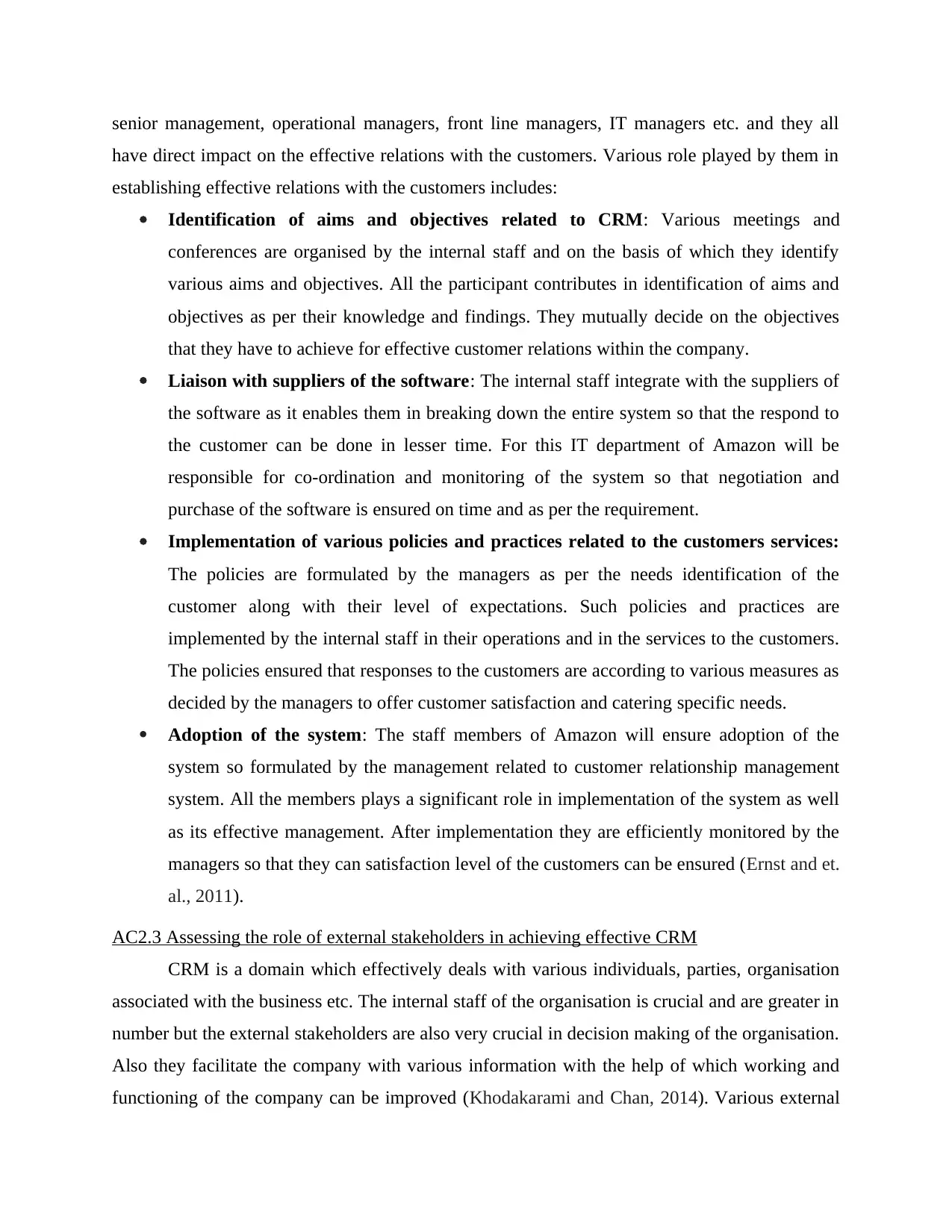
senior management, operational managers, front line managers, IT managers etc. and they all
have direct impact on the effective relations with the customers. Various role played by them in
establishing effective relations with the customers includes:
Identification of aims and objectives related to CRM: Various meetings and
conferences are organised by the internal staff and on the basis of which they identify
various aims and objectives. All the participant contributes in identification of aims and
objectives as per their knowledge and findings. They mutually decide on the objectives
that they have to achieve for effective customer relations within the company.
Liaison with suppliers of the software: The internal staff integrate with the suppliers of
the software as it enables them in breaking down the entire system so that the respond to
the customer can be done in lesser time. For this IT department of Amazon will be
responsible for co-ordination and monitoring of the system so that negotiation and
purchase of the software is ensured on time and as per the requirement.
Implementation of various policies and practices related to the customers services:
The policies are formulated by the managers as per the needs identification of the
customer along with their level of expectations. Such policies and practices are
implemented by the internal staff in their operations and in the services to the customers.
The policies ensured that responses to the customers are according to various measures as
decided by the managers to offer customer satisfaction and catering specific needs.
Adoption of the system: The staff members of Amazon will ensure adoption of the
system so formulated by the management related to customer relationship management
system. All the members plays a significant role in implementation of the system as well
as its effective management. After implementation they are efficiently monitored by the
managers so that they can satisfaction level of the customers can be ensured (Ernst and et.
al., 2011).
AC2.3 Assessing the role of external stakeholders in achieving effective CRM
CRM is a domain which effectively deals with various individuals, parties, organisation
associated with the business etc. The internal staff of the organisation is crucial and are greater in
number but the external stakeholders are also very crucial in decision making of the organisation.
Also they facilitate the company with various information with the help of which working and
functioning of the company can be improved (Khodakarami and Chan, 2014). Various external
have direct impact on the effective relations with the customers. Various role played by them in
establishing effective relations with the customers includes:
Identification of aims and objectives related to CRM: Various meetings and
conferences are organised by the internal staff and on the basis of which they identify
various aims and objectives. All the participant contributes in identification of aims and
objectives as per their knowledge and findings. They mutually decide on the objectives
that they have to achieve for effective customer relations within the company.
Liaison with suppliers of the software: The internal staff integrate with the suppliers of
the software as it enables them in breaking down the entire system so that the respond to
the customer can be done in lesser time. For this IT department of Amazon will be
responsible for co-ordination and monitoring of the system so that negotiation and
purchase of the software is ensured on time and as per the requirement.
Implementation of various policies and practices related to the customers services:
The policies are formulated by the managers as per the needs identification of the
customer along with their level of expectations. Such policies and practices are
implemented by the internal staff in their operations and in the services to the customers.
The policies ensured that responses to the customers are according to various measures as
decided by the managers to offer customer satisfaction and catering specific needs.
Adoption of the system: The staff members of Amazon will ensure adoption of the
system so formulated by the management related to customer relationship management
system. All the members plays a significant role in implementation of the system as well
as its effective management. After implementation they are efficiently monitored by the
managers so that they can satisfaction level of the customers can be ensured (Ernst and et.
al., 2011).
AC2.3 Assessing the role of external stakeholders in achieving effective CRM
CRM is a domain which effectively deals with various individuals, parties, organisation
associated with the business etc. The internal staff of the organisation is crucial and are greater in
number but the external stakeholders are also very crucial in decision making of the organisation.
Also they facilitate the company with various information with the help of which working and
functioning of the company can be improved (Khodakarami and Chan, 2014). Various external
⊘ This is a preview!⊘
Do you want full access?
Subscribe today to unlock all pages.

Trusted by 1+ million students worldwide

stakeholders for the Amazon includes the shareholders, suppliers, customers etc. and they play
following role in the achieving effective CRM includes:
Sharing information: For achieving the objectives of the organisation it is crucial that
they have better information on the basis of which they can take decisions. The suppliers
and other channel partners facilitates Amazon in identifying the expectations of the
customers according to which various strategies for serving the customers are identified
by them. Along with this all the requirement of the distributors and suppliers are
managed by the Amazon which implies that they have effective CRM practices (Ku,
2010).
Agreeing strategies: The external stakeholders of the organisation are treated as the
promoting agent of the organisation as they share the modern management practices
which are adopted by other organisation so that they can improve the internal functioning
of the organisation. In addition to these the external stakeholders comply with the
practices and stargates adopted by the Amazon so that they can agree on a common
platform and can work at same platform.
Reporting: The effectiveness in communication among the management of the
organisation with the stakeholders enable the company in ensuring better flow of the
information and knowledge among the parties. With effectiveness in the reporting format
the top management of Amazon have intelligence as they can easily and efficiently
analyse their working and the significance of the issues reflected by them (Wang and
Feng, 2012).
Feedback system: To ensure the success of the organisation it is crucial for them to have
efficient feedback system as with the help of this they can rectify various drawbacks
within the system of the Amazon in terms of their processes and services. CRM aims to
improve the communication process within the organisation and an effective feedback
system is considered to be a tool which ensures better communication by managing the
various hurdles.
2D1 Analysis of impact of employee engagement on CRM
Employee engagement has direct influence on effective CRM in which the relationship
between the employees and the organisation are taken into consideration. With the help of better
engagement of the employees improvement in the reputation and interest of the organisation can
following role in the achieving effective CRM includes:
Sharing information: For achieving the objectives of the organisation it is crucial that
they have better information on the basis of which they can take decisions. The suppliers
and other channel partners facilitates Amazon in identifying the expectations of the
customers according to which various strategies for serving the customers are identified
by them. Along with this all the requirement of the distributors and suppliers are
managed by the Amazon which implies that they have effective CRM practices (Ku,
2010).
Agreeing strategies: The external stakeholders of the organisation are treated as the
promoting agent of the organisation as they share the modern management practices
which are adopted by other organisation so that they can improve the internal functioning
of the organisation. In addition to these the external stakeholders comply with the
practices and stargates adopted by the Amazon so that they can agree on a common
platform and can work at same platform.
Reporting: The effectiveness in communication among the management of the
organisation with the stakeholders enable the company in ensuring better flow of the
information and knowledge among the parties. With effectiveness in the reporting format
the top management of Amazon have intelligence as they can easily and efficiently
analyse their working and the significance of the issues reflected by them (Wang and
Feng, 2012).
Feedback system: To ensure the success of the organisation it is crucial for them to have
efficient feedback system as with the help of this they can rectify various drawbacks
within the system of the Amazon in terms of their processes and services. CRM aims to
improve the communication process within the organisation and an effective feedback
system is considered to be a tool which ensures better communication by managing the
various hurdles.
2D1 Analysis of impact of employee engagement on CRM
Employee engagement has direct influence on effective CRM in which the relationship
between the employees and the organisation are taken into consideration. With the help of better
engagement of the employees improvement in the reputation and interest of the organisation can
Paraphrase This Document
Need a fresh take? Get an instant paraphrase of this document with our AI Paraphraser
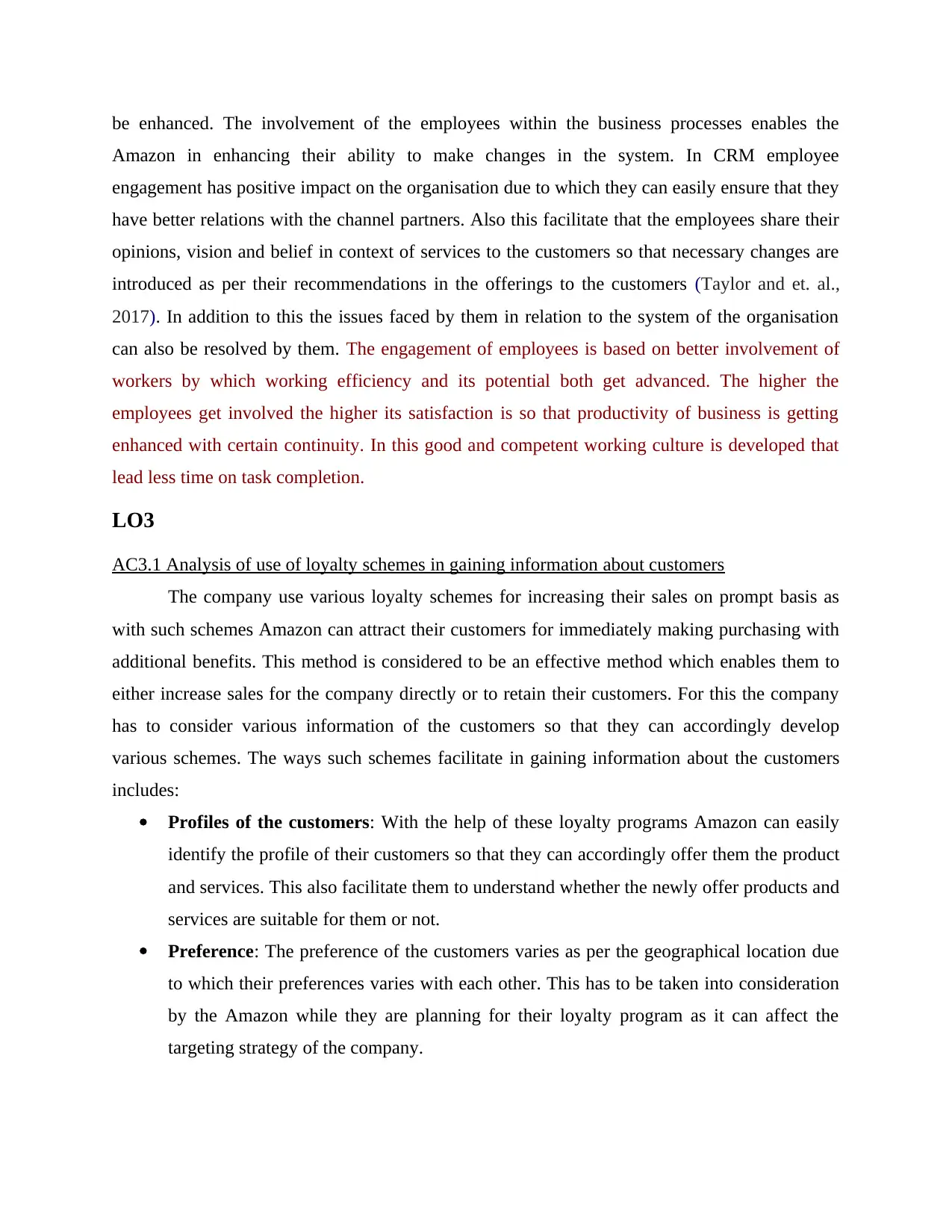
be enhanced. The involvement of the employees within the business processes enables the
Amazon in enhancing their ability to make changes in the system. In CRM employee
engagement has positive impact on the organisation due to which they can easily ensure that they
have better relations with the channel partners. Also this facilitate that the employees share their
opinions, vision and belief in context of services to the customers so that necessary changes are
introduced as per their recommendations in the offerings to the customers (Taylor and et. al.,
2017). In addition to this the issues faced by them in relation to the system of the organisation
can also be resolved by them. The engagement of employees is based on better involvement of
workers by which working efficiency and its potential both get advanced. The higher the
employees get involved the higher its satisfaction is so that productivity of business is getting
enhanced with certain continuity. In this good and competent working culture is developed that
lead less time on task completion.
LO3
AC3.1 Analysis of use of loyalty schemes in gaining information about customers
The company use various loyalty schemes for increasing their sales on prompt basis as
with such schemes Amazon can attract their customers for immediately making purchasing with
additional benefits. This method is considered to be an effective method which enables them to
either increase sales for the company directly or to retain their customers. For this the company
has to consider various information of the customers so that they can accordingly develop
various schemes. The ways such schemes facilitate in gaining information about the customers
includes:
Profiles of the customers: With the help of these loyalty programs Amazon can easily
identify the profile of their customers so that they can accordingly offer them the product
and services. This also facilitate them to understand whether the newly offer products and
services are suitable for them or not.
Preference: The preference of the customers varies as per the geographical location due
to which their preferences varies with each other. This has to be taken into consideration
by the Amazon while they are planning for their loyalty program as it can affect the
targeting strategy of the company.
Amazon in enhancing their ability to make changes in the system. In CRM employee
engagement has positive impact on the organisation due to which they can easily ensure that they
have better relations with the channel partners. Also this facilitate that the employees share their
opinions, vision and belief in context of services to the customers so that necessary changes are
introduced as per their recommendations in the offerings to the customers (Taylor and et. al.,
2017). In addition to this the issues faced by them in relation to the system of the organisation
can also be resolved by them. The engagement of employees is based on better involvement of
workers by which working efficiency and its potential both get advanced. The higher the
employees get involved the higher its satisfaction is so that productivity of business is getting
enhanced with certain continuity. In this good and competent working culture is developed that
lead less time on task completion.
LO3
AC3.1 Analysis of use of loyalty schemes in gaining information about customers
The company use various loyalty schemes for increasing their sales on prompt basis as
with such schemes Amazon can attract their customers for immediately making purchasing with
additional benefits. This method is considered to be an effective method which enables them to
either increase sales for the company directly or to retain their customers. For this the company
has to consider various information of the customers so that they can accordingly develop
various schemes. The ways such schemes facilitate in gaining information about the customers
includes:
Profiles of the customers: With the help of these loyalty programs Amazon can easily
identify the profile of their customers so that they can accordingly offer them the product
and services. This also facilitate them to understand whether the newly offer products and
services are suitable for them or not.
Preference: The preference of the customers varies as per the geographical location due
to which their preferences varies with each other. This has to be taken into consideration
by the Amazon while they are planning for their loyalty program as it can affect the
targeting strategy of the company.

Purchasing Pattern of the customers: The company must identify the purchasing
pattern of the customers as they purchase those products only which are useful for them.
Identification of such pattern will enable Amazon in offering to the customers better
value as per their requirement and this ensures that they hold their customers for a longer
period of time (Su, Tsai and Hsu, 2010).
Opinions of the customers: The opinions of the customers for various issues faced must
be analysed by the company as with the help of deeper and clear understanding of the
opinions Amazon can can easily launch new products for the company as well as can
accordingly promote their existing products and services.
AC3.2 The way in which information gained in making decisions
With the increasing competition in the market it is crucial for the organisation to take into
consideration the factors that has direct impact on the purchasing decisions of the customers. For
this the focus of the companies is on the interactive marketing and the beliefs of the customers so
that they can directly emphasise on the needs and wants of the customers. The information so
gathered by the marketing team of Amazon facilitate them to accordingly formulate various
strategies and policies which can ensure effective CRM. By taking into various information so
gathered by the marketing team of the company it can be ensured that customer centric offerings
are provided to the customers along with those promotional strategies which can directly
influence the behaviour of the customers for making purchases. Amazon offers sales to their
customers as per the festive seasons or any other occasion in which they make purchases and this
is dependent on the geographical factors. Along with this various innovative technology, tools
and methods will be used by them as per the taste and requirement of the customers. This will
enable the company in advertising, designings and promoting their offerings through online
platform (Coltman, Devinney and Midgley, 2011). By adopting various schemes as per the
information gathered by them they can directly increase their revenue and thus can take
competitive advantage over others.
3D1 Evaluation of methods which help in segmenting customers as a part of CRM process
For the organisation it is crucial that they segment their customers efficiently with the
help of various methods. In the CRM process the team of Amazon focus upon various factors
while considering the segmentation of their target market. Segmentation of the market is done on
the basis of behaviour, geographical location, demographics factors etc. The Amazon take into
pattern of the customers as they purchase those products only which are useful for them.
Identification of such pattern will enable Amazon in offering to the customers better
value as per their requirement and this ensures that they hold their customers for a longer
period of time (Su, Tsai and Hsu, 2010).
Opinions of the customers: The opinions of the customers for various issues faced must
be analysed by the company as with the help of deeper and clear understanding of the
opinions Amazon can can easily launch new products for the company as well as can
accordingly promote their existing products and services.
AC3.2 The way in which information gained in making decisions
With the increasing competition in the market it is crucial for the organisation to take into
consideration the factors that has direct impact on the purchasing decisions of the customers. For
this the focus of the companies is on the interactive marketing and the beliefs of the customers so
that they can directly emphasise on the needs and wants of the customers. The information so
gathered by the marketing team of Amazon facilitate them to accordingly formulate various
strategies and policies which can ensure effective CRM. By taking into various information so
gathered by the marketing team of the company it can be ensured that customer centric offerings
are provided to the customers along with those promotional strategies which can directly
influence the behaviour of the customers for making purchases. Amazon offers sales to their
customers as per the festive seasons or any other occasion in which they make purchases and this
is dependent on the geographical factors. Along with this various innovative technology, tools
and methods will be used by them as per the taste and requirement of the customers. This will
enable the company in advertising, designings and promoting their offerings through online
platform (Coltman, Devinney and Midgley, 2011). By adopting various schemes as per the
information gathered by them they can directly increase their revenue and thus can take
competitive advantage over others.
3D1 Evaluation of methods which help in segmenting customers as a part of CRM process
For the organisation it is crucial that they segment their customers efficiently with the
help of various methods. In the CRM process the team of Amazon focus upon various factors
while considering the segmentation of their target market. Segmentation of the market is done on
the basis of behaviour, geographical location, demographics factors etc. The Amazon take into
⊘ This is a preview!⊘
Do you want full access?
Subscribe today to unlock all pages.

Trusted by 1+ million students worldwide
1 out of 18
Related Documents
Your All-in-One AI-Powered Toolkit for Academic Success.
+13062052269
info@desklib.com
Available 24*7 on WhatsApp / Email
![[object Object]](/_next/static/media/star-bottom.7253800d.svg)
Unlock your academic potential
Copyright © 2020–2025 A2Z Services. All Rights Reserved. Developed and managed by ZUCOL.




